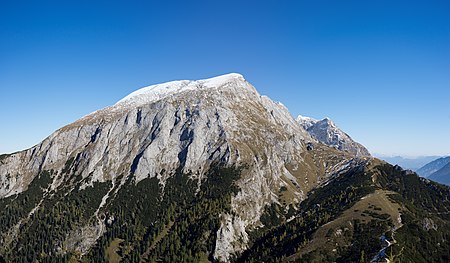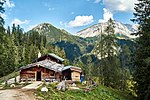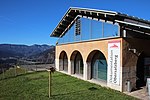Hohes Brett
Berchtesgaden AlpsCommons link is defined as the pagenameMountains of BavariaMountains of the AlpsTwo-thousanders of Austria ... and 1 more
Two-thousanders of Germany

The Hohes Brett is a mountain, 2,340 m (7,680 ft) above sea level according to the German system or 2,338 m (7,671 ft) according to the Austrian system, in the Göll massif of the Berchtesgaden Alps. The border between Germany (Bavaria) and Austria (Salzburg) runs across its peak. Its name, meaning "High Plank" in German, refers to the flat, rocky plateau near the summit which offers panoramic views of the surrounding areas including the Watzmann's east face, the Hagen Mountains and the Steinernes Meer. For a mountain of its height it is easy to scale and thus sees a lot of visitors.
Excerpt from the Wikipedia article Hohes Brett (License: CC BY-SA 3.0, Authors, Images).Hohes Brett
Schützensteig Klettersteig,
Geographical coordinates (GPS) Address Nearby Places Show on map
Geographical coordinates (GPS)
| Latitude | Longitude |
|---|---|
| N 47.583333333333 ° | E 13.033333333333 ° |
Address
Schützensteig Klettersteig
83471
Bavaria, Germany
Open on Google Maps










